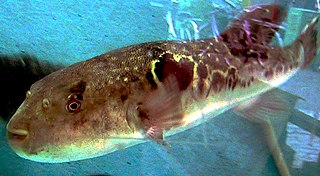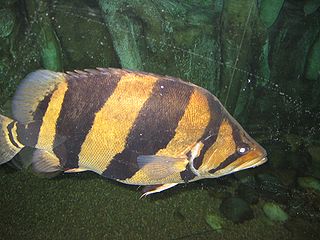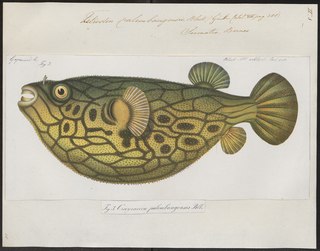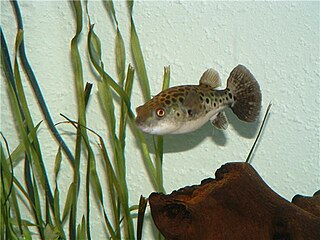
Tetraodontidae is a family of primarily marine and estuarine fish of the order Tetraodontiformes. The family includes many familiar species variously called pufferfish, puffers, balloonfish, blowfish, blowers, blowies, bubblefish, globefish, swellfish, toadfish, toadies, toadle, honey toads, sugar toads, and sea squab. They are morphologically similar to the closely related porcupinefish, which have large external spines. The scientific name refers to the four large teeth, fused into an upper and lower plate, which are used for crushing the hard shells of crustaceans and mollusks, their natural prey.

Takifugu, also known by the Japanese name fugu, is a genus of pufferfish with 25 species, most of which are native to salt and brackish waters of the northwest Pacific, but a few species are found in freshwater in Asia or more widely in the Indo-Pacific region. Their diet consists mostly of algae, molluscs, invertebrates and sometimes crustaceans.

Tetraodon is a genus in the pufferfish family (Tetraodontidae) found in freshwater in Africa. It is the type genus of the family and historically included numerous other species; several Asian species were moved to the genera Dichotomyctere, Leiodon and Pao in 2013.

The Mbu pufferfish, also known as Mbuna pufferfish, giant pufferfish, or giant freshwater pufferfish, is a carnivorous freshwater pufferfish originating from the middle and lower sections of the Congo River in Africa, as well as the east coast of Lake Tanganyika near the Malagarasi River mouth.

The fahaka pufferfish, also known as the Nile puffer, globe fish, lineatus puffer, is a tropical freshwater pufferfish found in the upper Nile, Chad, Senegal, Gambia, Geba, Volta and Turkana basins in West, Northeast and East Africa.

The Congo puffer or potato puffer is a freshwater pufferfish found in areas of the Congo River in Africa, including rapids.

Carinotetraodon is a polyphyletic genus of small freshwater pufferfish found in South and Southeast Asia.Several species have commercial importance as aquarium fish.

Dichotomyctere ocellatus, commonly the figure 8 puffer or eyespot puffer, is a pufferfish found in freshwater in Southeast Asia. It is known from the lower reaches of the Mekong (Cambodia), the Peninsular Malaysia as well as Borneo.

The dwarf pufferfish, also known as the Malabar pufferfish, pygmy pufferfish, or pea pufferfish, is a small freshwater pufferfish endemic to Kerala and southern Karnataka in Southwest India. They are popular in aquaria for their bright colours and small size. At a maximum total length of 3.5 cm, dwarf pufferfish are one of the smallest pufferfish in the world. They closely resemble the related Carinotetraodon imitator, and the two can be difficult to distinguish. C. imitator was not recognised as a different species until 1999.

A brackish-water aquarium is an aquarium where the water is brackish (semi-salty). The range of "saltiness" varies greatly, from near freshwater to near marine and is often referred to as specific gravity (SG) or salinity. Brackish water aquaria is a popular specialization within the fishkeeping hobby. Many species of fish traded as freshwater species are actually true brackish species, for example mollies, Florida flagfish, and some cichlids such as chromides and black-chin tilapia. There are also several popular species traded purely as brackish water fish, including monos, scats, archerfish, and various species of pufferfish, goby, flatfish, and gar. Generally, aquarists need to maintain a specific gravity of around 1.005 to 1.010 depending on the species being kept, but practically all brackish water fish tolerate variations in salinity well, and some aquarists maintain that regularly fluctuating the salinity in the aquarium actually keeps the fish healthy and free of parasites.

Colomesus asellus, the Amazon puffer, asellus puffer, South American freshwater puffer, Peruvian puffer, or Brazilian puffer is a species of pufferfish confined to the Amazon, Essequibo and Orinoco basins in tropical South America. It is a popular aquarium species.

Colomesus psittacus, the Banded puffer, parrot puffer or South American estuarine puffer, is a species of pufferfish found all along the Western Atlantic coastline of South America from the Gulf of Paria down to the mouth of the Amazon River in Brazil.

Carinotetraodon irrubesco, known commonly as the red-tail dwarf puffer, is a freshwater pufferfish found only in the lower Banyuasin basin in South Sumatra and the Sambas River in West Kalimantan.
Pao suvattii, or Arrowhead puffer, is a species of pufferfish. It is a medium-sized pufferfish, reaching 11.5 cm (4.5 in) SL. It is also known as a Pignose Puffer or a Mekong Puffer. It is locally common in the Lower Mekong basin, and is exclusively a freshwater fish.

The green pufferfish or Ceylon pufferfish is a species of pufferfish found in South and Southeast Asia. Its habitat includes rivers, estuaries, lakes and flood plains. It lives in fresh to slightly brackish water.

Pao palembangensis, is a species of freshwater pufferfish native to Thailand, Laos, Malaysia and Indonesia in Southeast Asia. Its commonly called the humpback puffer or dragon puffer. It is bred for aquaria as an ornamental fish because of its beautiful skin colouration and pattern.

Dichotomyctere sabahensis is a species of pufferfish endemic to the southeast Asian island of Borneo. This species grows to a standard length of 10.8 cm (4.3 in).

Pao is a genus of mostly freshwater pufferfish with one species also occurring in brackish water. They are found in Southeast Asia. Until 2013, its species were generally placed in Tetraodon.

Dichotomyctere is a genus of relatively small pufferfish found in both fresh and brackish waters in south and southeast Asia. Its species were generally included in the genus Tetraodon until 2013. The largest species of Dichotomyctere reach up to 17 cm (6.7 in) in length.















